Course instructor: Dr. Charlotte Martin de Fonjaudran
Course: Principles of conservation
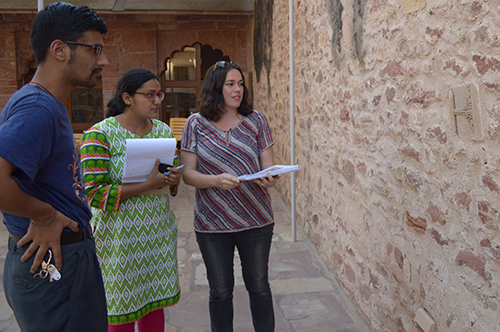
Dr. Martin de Fonjaudran gained a Masters in Art History at the Pantheon-Sorbonne University (Paris I, France) in 2001 and a Masters in the Conservation of Wall Painting at The Courtauld (London,UK) in 2004. Following a one-year internship in the Science Department of the Getty Conservation Institute (Los Angeles, USA) she was a Lecturer and MA fieldwork supervisor for the Conservation of Wall Painting Department of The Courtauld, working in China, India, Malta and Cyprus. She continued her work with the Courtauld as a freelance conservator, managing wall painting projects in Malta and India involving environmental assessment and control measures as well as scientific investigations and remedial interventions. She jointly managed the wall painting conservation project at Nagaur from 2006-12.
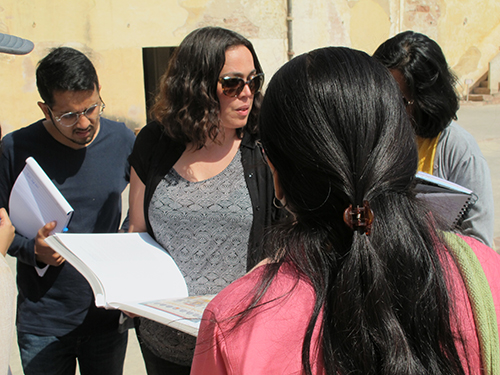
In September 2014 she obtained her PhD in Conservation at The Courtauld. Her research focused on cleaning issues affecting Asian wall paintings and on the development of an open-source image analysis workflow to assess cleaning effects.
Publications:
C. Martin de Fonjaudran, S. Menon and M. S. Gill, ‘Sumda Chun and other early wall paintings in Ladakh: practical and ethical conservation issues from failing structures to obscuring surface layers’, in D. Park, K. Wangmo, and S. Cather (eds), Art of Merit: Studies in Buddhist Art and its Conservation. Proceedings of the Buddhist Art Forum 2012, London, 2013, 203-18.
S. Tringham, C. Martin de Fonjaudran, C. di Giorgio and S. Cather, ‘Passive and remedial approaches to salt damage and biodeterioration of wall paintings and monuments in the Crypt of the Grand Masters, St John’s Co-Cathedral, Valletta’, in Wallpaintings in Crypts, Grottoes, Catacombs: Strategies for the Conservation of Coated Surfaces in Damp Environments (Proceedings of the ICOMOS conference at Quedlinburg, 3-6 November 2011), ed. T. Danzl, M. Exner and E. Rüber-Schütte, Journal of the ICOMOS German National Committee, 56 (2013) 85-9.
C. Martin de Fonjaudran, S. Tringham, S. Bogin, S. Menon, and K. Jasol, ‘Cultural identity, conservation approaches and dissemination: conserving the wall paintings of Nagaur Fort, Rajasthan, India’ in ICOM-CC Preprints of the 16th triennial conference, Lisbon, 19-23 September 2011 (e-publication, no pagination).
C. Martin de Fonjaudran, A. Nevin, F. Piqué, and S. Cather ‘Stratigraphic analysis of organic materials in wall painting samples using micro-FTIR attenuated total reflectance and a novel sample preparation technique’, in Analytical and Bioanalytical Chemistry, 392 (1-2) 77-86.
S. Bogin, C. Martin de Fonjaudran and S. Tringham, ‘Conserving the Palace of Mirrors at Nagaur, Rajasthan’, in Courtauld News (23 Spring 2008), 14-5.
Course instructor: Sam Whittaker
Course: Condition assessment with technical imaging
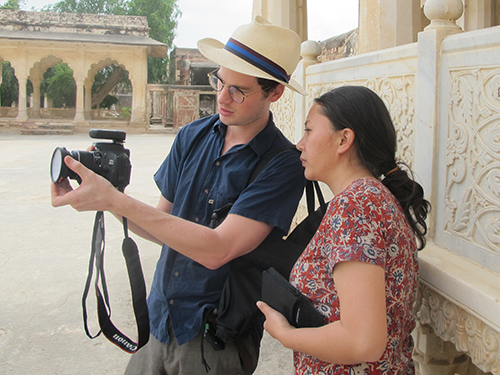
Following completion of a BA in Fine Art at Central Saint Martins, University of the Arts, Whittaker undertook an MA in the Conservation of Wall Painting at The Courtauld.
He then took up a graduate internship at the Getty Conservation Institute in Los Angeles. This entailed work on both the conservation and management of the wall paintings of the Tomb of Tutankhamen and the documentation and condition assessment of Kasbah Taourirt, Morocco. During this internship he expanded his imaging expertise by researching the application of 3D-imaging techniques to map deterioration phenomena and quantify rates of change through image analysis.
He has been a conservator on Courtauld projects in India, Bhutan, Cyprus and Georgia and has supervised MA conservation students at Bundi and Nagaur in India, Tamzhing and Tango in Bhutan and Vardzia in Georgia.
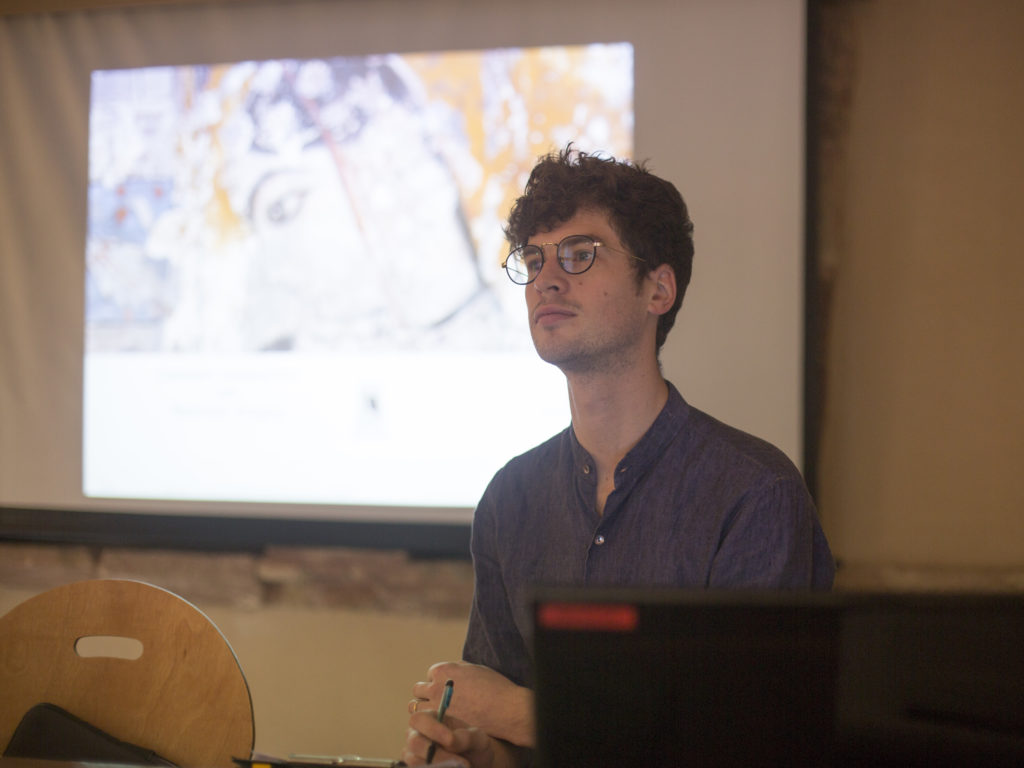
Whittaker is a co-founder and director of Opus Conservation, where he leads a variety of projects. Examples include the Palace of Westminster (The Royal Gallery), The Old Royal Naval College (The Painted Hall) and Historic Royal Palaces (Hampton Court Palace, Kensington Palace and the Tower of London). These involve technical imaging, photogrammetry, condition assessment and the treatment and monitoring of wall paintings.
Publications
Percy, C. Ouimet, S, Ward, M. Santana Quintero, C. Cancino, L. Wong, B. Marcus,S. Whittaker, M. Boussalh, ‘Documentation for emergency condition mapping of decorated historic surfaces at the Caid Residence, the Kasbah of Taourirt (Ouarzazate, Morocco)’, ISPRS Annals of the Photogrammetry, Remote Sensing and Spatial Information Sciences 2.5, 2015 229—234.
C. Martin de Fonjaudran, A. Acocella, G. Accorsi, D. Tamburini, G. Verri, A. Rava, S. Whittaker, F. Zerbetto and D. Saunders, ‘Optical and theoretical investigation of Indian yellow’, Dyes and Pigments, 144, 2017 234—241.
D. Tamburini, C. Martin de Fonjaudran, G. Verri, G. Accorsi, A. Acocella, F. Zerbetto, A. Rava, S. Whittaker, D. Saunders, and S. Cather, ‘New Insights into the Composition of Indian Yellow and Its Use in a Rajasthani Wall Painting’. Microchemical Journal, 137, 2018 238—49.
Course instructor: Eugenia Geddes da Filicaia
Course: Environmental Monitoring and Assessment
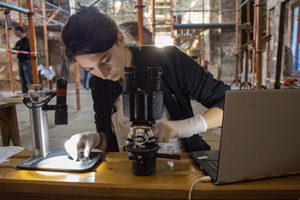 Following her Master’s degree in Chemistry at The University of Sussex, Eugenia undertook the MA in Wall Painting Conservation at The Courtauld Institute of Art, where she graduated in 2016.
Following her Master’s degree in Chemistry at The University of Sussex, Eugenia undertook the MA in Wall Painting Conservation at The Courtauld Institute of Art, where she graduated in 2016.
Since then Eugenia has taught scientific analysis and environmental monitoring for conservation at The Dunhuang Academy (China), has been an Associate Lecturer at The Courtauld Institute of Art, and has supervised MA students on their fieldwork in Nagaur (India). She undertook an internship at Art-Test Firenze, carrying out scientific analysis for the restoration, authentication and attribution of works of art, utilising imaging and analytical techniques such as MSI, IR-reflectography, X-ray radiography, and XRF.
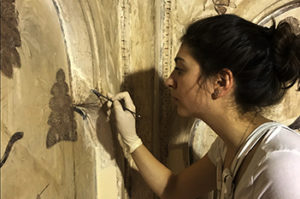
Eugenia has been working as a freelance conservator on Courtauld projects in Ateni (Georgia), Bundi, and Nagaur (India), and in the private sector in the UK. Sites include The Royal Hospital, Chelsea (Rickerby and Shekede), The Painted Hall in the Old Royal Naval College, Greenwich (Paine & Stewart), and the Tower of London and Hampton Court Palace (Opus Conservation for Historic Royal Palaces). The projects encompassed processing environmental monitoring data, investigation of original technology and assessment of condition, and planning, testing and implementation of remedial treatments.
Publications :
E. Geddes da Filicaia, G. Verri, Y. Goren, ‘Field microscopy applied to the understanding of the technology and conservation of wall paintings’, IOP Conference Series: Materials Science and Engineering, Volume 364, Conference 1, (2018) 012062.
Course instructor: Amarilli Rava
Course: Assessing materials for conservation
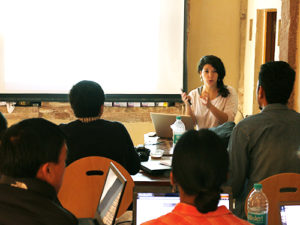
Following a BA in oriental art and archeology, Amarilli graduated in 2010 from the master’s degree in the conservation of wall painting at The Courtauld Institute of Art with an award-winning dissertation. Since finishing her MA she worked with the Getty Conservation Institute, participating on projects for the conservation and management of the wall paintings of the tomb of Tutankhamen and the conservation of Cave 85 in Mogao, China.
From 2012 to 2018 Amarilli managed and supervised international fieldwork projects for the Courtauld Institute of Art, with whom she held a lectureship position until early 2018.
She recently worked with the UNESCO office in Kabul, where she participated on the Afghanistan Heritage and Extractive Industries Development Initiative.
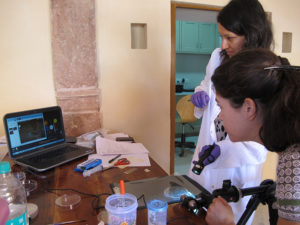
Amarilli is currently undertaking a joint PhD with the Courtauld Institute of Art and University College London.
Her research focuses on assessing interventions for the re-adhesion of paint layers on lime plaster. She joined the private firm Opus Conservation in October 2018.
Publications :
G. Accorsi, G. Verri, A. Acocella, D. Saunders, C Martin de Fonjaudran, D. Tamburini, A. Rava, S. Whittaker, F. Zerbetto, ‘Photophysics of artist’s pigments’ Measurement, 123, (2018) p. 293-297.
D. Tamburini, C. Martin de Fonjaudran, G. Verri, G. Accorsi, A. Acocella, F. Zerbetto, A. Rava, S. Whittaker, D. Saunders, S. Cather, ‘New insights into the composition of Indian yellow and its use in a Rajasthani wall painting’ Microchemical Journal, 137, (2018) p. 238-249.
C. Martin de Fonjaudran, A. Acocella, G. Accorsi, D. Tamburini, G. Verri, A. Rava, S. Whittaker, F. Zerbetto, D. Saunders, ‘Optical and theoretical investigation of Indian yellow (euxanthic acid and euxanthone)’ Dyes and Pigments, 144 (2017) 234-241.
L. Wong, Su Bomin, Wang Xiaowei, A. Rava and N. Agnew, ‘Salt-induced flaking of wall paintings at the Mogao Grottoes, China’ Proceedings of the 4th International Conference on Salt Weathering of Buildings and Stone Sculptures, 20-22 September 2017.
L. Wong, S. Rickerby, A. Rava, A. Phenix, J. Mazurek, R. Kamel, ‘Examination of the wall paintings in Tutankhamen’s tomb: inconsistencies in original technology,’ in The Decorative: Conservation and the Applied Arts (Contributions to the Vienna Congress 10-14 September 2012), ed. S. Cather et al., London, 2012, 322-30.
L. Wong, S. Rickerby, A. Rava, A. Sharkawi, ‘Developing approaches for conserving painted plasters in the royal tombs of the Valley of the Queens’, Proceedings of the 11th International Conference on the Study and Conservation of Earthen Architectural Heritage, Terra 2012, Lima, Peru (e-proceedings).
Presentations
A. Rava, S. Cather, F. Piquè, K. Soppa, S. Downes E. Richardson, ‘Unilateral NMR and fluorescent labelling to evaluate penetration and deposition of adhesives for conservation treatments’ unpublished presentation at the 2017 Thz-Bio workshop 6-8 October 2017, ENEA Centre, Frascati, Italy.
A. Rava, A. Burnstock, K. Soppa, F. Piquè, S. Downes, E. Richardson, ‘Re-adhesion of paint layers on lime plaster: assessment of penetration and deposition with unilateral NMR and fluorescent labelling’, unpublished presentation for the VIII International Congress, Colore e Conservazione: support (the) image, Consolidation and conservation issues in modern and contemporary painting supports, CESMAR 7, Università Ca’ Foscari, Venezia, Italy.
Course instructor: Giovanni Verri
Course: Multispectral Imaging
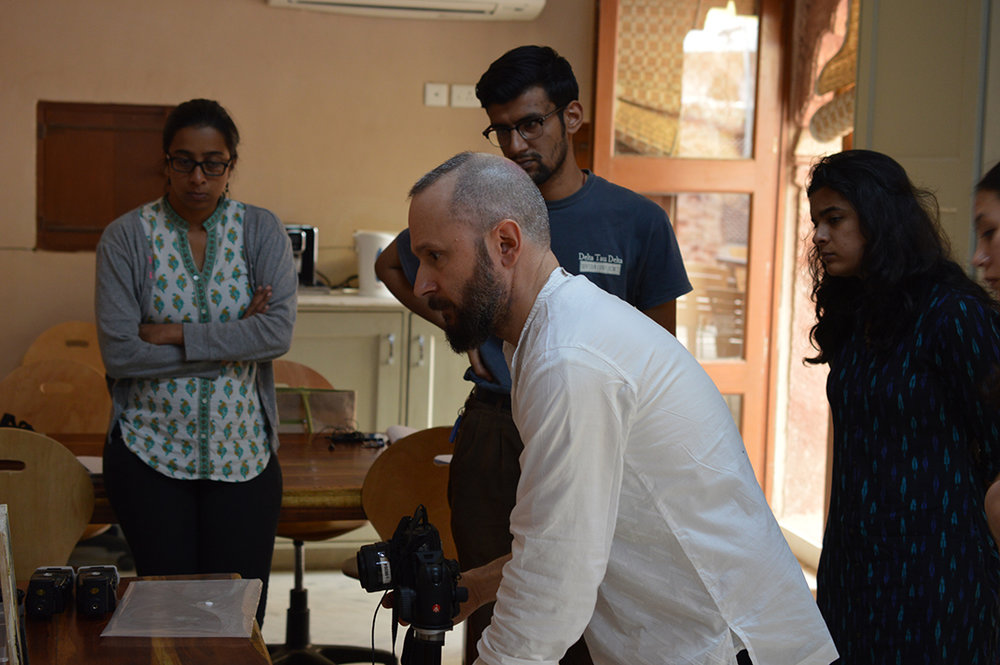 Dr. Verri graduated with a degree in Physics from the University of Ferrara, with a dissertation in technical imaging applied to paintings, and completed a PhD in Physics at the same institution. He coordinated the non-invasive investigations of the Organic Materials in Wall Paintings project with the Getty Conservation Institute in 2003. Having sparked his interest in conservation-related issues, Verri then undertook an MA in Conservation of Wall Painting at The Courtauld (2004-2007). In 2007, he was appointed Mellon Fellow at the British Museum, where he developed multispectral imaging for the conservation of artistic and archaeological materials. During his dissertation, and later at the British Museum, he developed an imaging technique called visible-induced luminescence imaging for the characterisation of Egyptian blue, Han blue and Han purple.
Dr. Verri graduated with a degree in Physics from the University of Ferrara, with a dissertation in technical imaging applied to paintings, and completed a PhD in Physics at the same institution. He coordinated the non-invasive investigations of the Organic Materials in Wall Paintings project with the Getty Conservation Institute in 2003. Having sparked his interest in conservation-related issues, Verri then undertook an MA in Conservation of Wall Painting at The Courtauld (2004-2007). In 2007, he was appointed Mellon Fellow at the British Museum, where he developed multispectral imaging for the conservation of artistic and archaeological materials. During his dissertation, and later at the British Museum, he developed an imaging technique called visible-induced luminescence imaging for the characterisation of Egyptian blue, Han blue and Han purple.
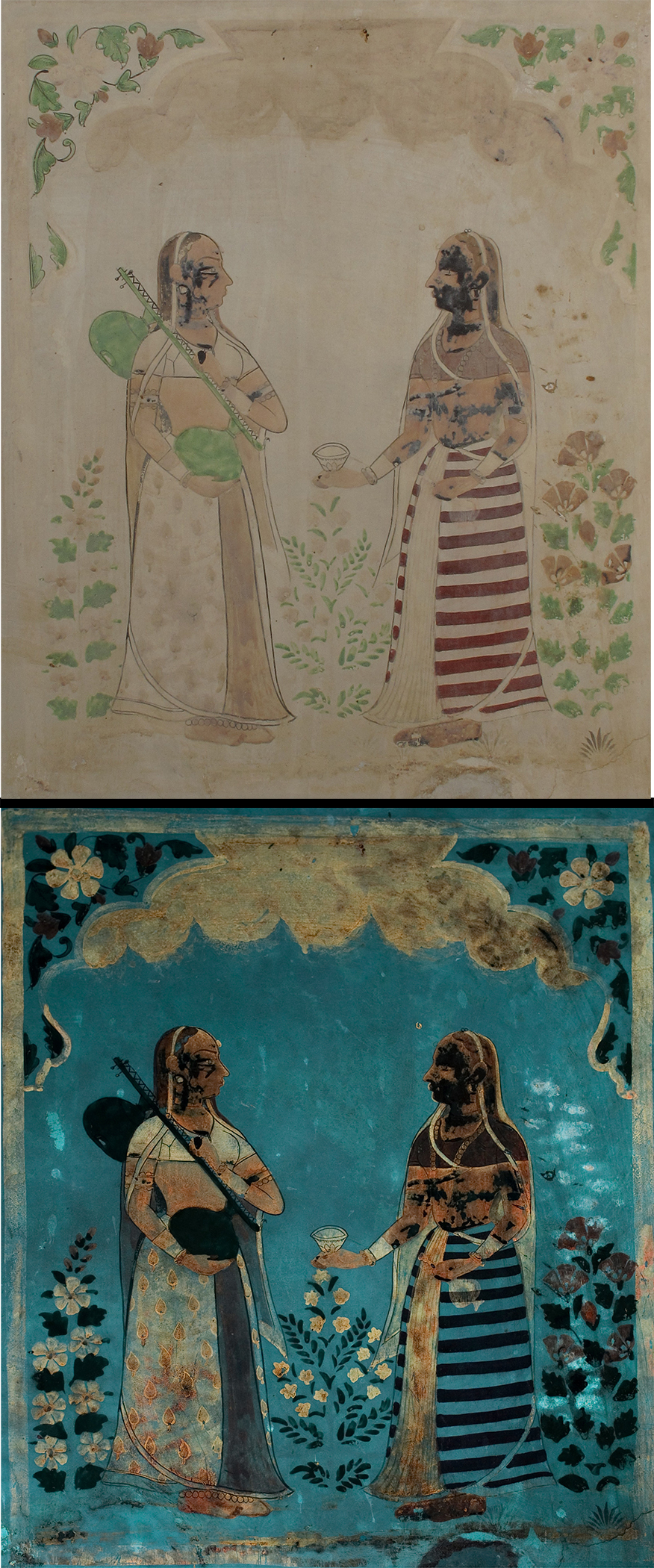
This imaging technique-now adopted by a large number of international institutions-has since been used on several artworks, including the wall paintings in the Tomb of Tutankhamen, Egypt, the Nike of Samothrace at the Louvre, Paris, France, the Caryatid Porch in Athens, Greece and the Parthenon sculptures and Mausoleum at Halicarnassus at the British Museum, UK.
More recently, he developed a flash-based setup for an economically viable multispectral imaging system. Verri is now a Reader at The Courtauld, coordinating the MA programme in Buddhist Art: History and Conservation.
Publications:
G. Verri, “It’s all imaging to me”: Documentation, Investigation, Visualisation and Communication’, Conservation Perspectives: The GCI Newsletter, 32, 1, 2017 4—9
C. Martin de Fonjaudran, A. Acocella, G. Accorsi, D. Tamburini, G. Verri, A. Rava, S. Whittaker, F. Zerbetto and D. Saunders, ‘Optical and theoretical investigation of Indian yellow’, Dyes and Pigments, 144, 2017 234—241.
L. Parodi and G. Verri, ‘Infrared reflectography of the Mughal painting Princes of the House of Timur (British Museum, 1913,0208,0.1), Journal of Islamic Manuscripts, 7, 1, 2016 36-65.
F. Piqué and G. Verri (eds), Organic Materials in Wall Paintings, 2015, The Getty Conservation Institute, Los Angeles.
J. Ambers, C.R. Cartwright, C. Higgitt, D. Hook, E. Passmore, St J. Simpson, G. Verri, C. Ward and B. Wills, Looted, Recovered, Returned: Antiquities from Afghanistan (A detailed scientific and conservation record of a group of ivory and bone furniture overlays excavated at Begram, stolen from the National Museum of Afghanistan, privately acquired on behalf of Kabul, analysed and conserved at the British Museum and returned to the National Museum of Afghanistan in 2012), 2014, Archaeopress: Oxford.
G. Verri, T. Opper and L. Lazzarini, ‘In picturae modum variata circumlitio? The reconstruction of the polychromy of a Roman ideal female head (Treu Head)’, in Diversamente Bianco, la policromia della scultura Romana, P. Liverani and U. Santamaria (eds), Edizioni Quasar, Rome 2014 149-183.
G. Verri, M. Gleba, J. Swaddling, T. Long, J. Ambers and T. Munden, ‘Etruscan women’s clothing and its decoration: the polychrome gypsum statue from the ‘Isis Tomb’ at Vulci’, The British Museum Technical Bulletin, 8 2014 59-72.
G. Verri and D. Saunders, ‘Xenon flash for reflectance and luminescence (multispectral) imaging in cultural heritage applications’, The British Museum Technical Bulletin, 8 2014 83-92.
S. Pagès-Camagna, L. Laugier, A. Blanc, E. Lambert, A. Maigret, J. Marsac and G. Verri, ‘La Victoire sous l’œil des scientifiques’ in La Victoire de Samothrace, Redécouvrir un chef-d’œuvre, J.-L. Martinez, L. Laugier and M. Hamiaux , Coédition musée du Louvre / Somogy éditions d’Art, Paris 2014 90-103.
J. Dyer, G. Verri and J. Cupitt, ‘Multispectral Imaging in Reflectance and Photo-induced Luminescence modes: a User Manual’, European CHARISMA Project, published online http://www.britishmuseum.org/pdf/charisma-multispectral-imaging-manual-2013.pdf 2013.
Course instructor: Dr. Caroline Kyi
Course : Biodeterioration and control
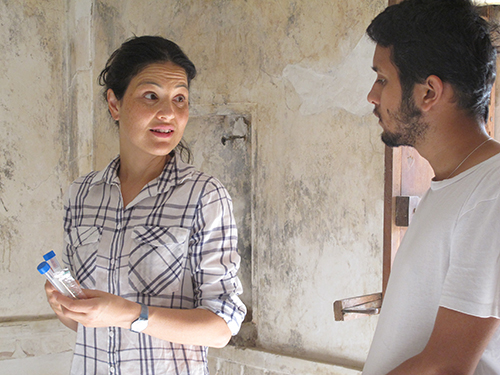 Dr. Kyi undertook the Postgraduate Diploma in the Conservation of Wall Painting at The Courtauld during 1997-2000 and carried out important research on the bioremediation of soluble nylon. Her PhD (Chemistry) from The University of Melbourne was on ‘Controlling biodeterioration of cultural materials: the use of free radical-based treatments to inhibit the communication pathways of microbial films’. Her research focuses on the conservation of wall paintings and the biodeterioration of cultural materials. Both her working and research concentrate on conservation issues presented by a range of moveable and immoveable cultural heritage in Australia and internationally.
Dr. Kyi undertook the Postgraduate Diploma in the Conservation of Wall Painting at The Courtauld during 1997-2000 and carried out important research on the bioremediation of soluble nylon. Her PhD (Chemistry) from The University of Melbourne was on ‘Controlling biodeterioration of cultural materials: the use of free radical-based treatments to inhibit the communication pathways of microbial films’. Her research focuses on the conservation of wall paintings and the biodeterioration of cultural materials. Both her working and research concentrate on conservation issues presented by a range of moveable and immoveable cultural heritage in Australia and internationally.
Dr. Kyi is currently working as a conservator based in Melbourne, Australia.
Selected publications:
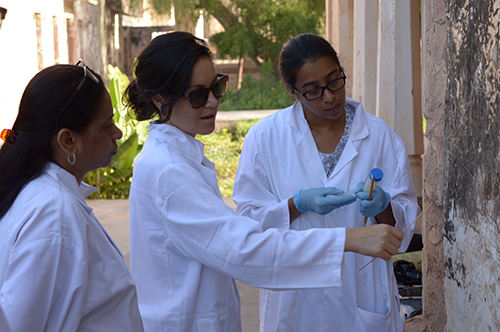
C. Kyi, R. Sloggett, P. McMillan, and C. Schiesser, ‘Nitric oxide: investigations into a potential (free) radical approach as a treatment alternative in the control of biodeterioration’, International Conference on Built Heritage: Monitoring, Conservation and Management, Milan, 2013.
C. Kyi, C. Schiesser, and R. Sloggett, ‘From test-tube to treatment: conservation considerations in the development of an alternative approach in the control of biodeterioration’, in The Meaning of Materials in Modern and Contemporary Art, Brisbane 10-11 December 2012 (AICCM Paintings Group, 20th-century in paint symposium).

C. Kyi, C. Schiesser and R. Sloggett, ‘NO• (nitric oxide) to biodeterioration; conservation of material culture,’ in Tropical Climates: Proceedings of the 3rd APTCCARN Meeting, Silpakorn University, Thailand 2012.
R. Slogget, C, Kyi, N. Tse, M. Tobin, L. Puskar, L. and A. Best, ‘Microanalysis of artworks: IR microspectroscopy of paint cross-sections’, Advanced Vibrational Spectroscopy, 53 (1) 2010, 77–82
C. Kyi, ‘The significance of appropriate sampling and cultivation in the effective assessment of biodeterioration’, in Zeitschrift für Kunsttechnologie und Konservierung, 2006, 344-52.
C. Kyi and R. Drew, ‘Bioremediation of soluble nylon: investigations of genetic information and enzymatic activities associated with the utilisation of soluble nylon as a substrate,’ in Tradition and Innovation: Advances in Conservation, IIC, London, 2000, 101-6.
Neil Greentree
Imaging
 Greentree has been a photographer for more than 40 years and photographing in India since 1974. He has produced many publications both as the photographer as well as in some cases working on the image file production side with a book designer, which enables successful and accurate printing of the images in their final book form. He has also been working at the Freer Gallery of Art in the Smithsonian, Washington DC, creating high-resolution digital files for the museum’s archives and public database platform as well as many other publications, books and websites. He taught on the Leon Levy programme in 2014, 2015, 2016 and 2017.
Greentree has been a photographer for more than 40 years and photographing in India since 1974. He has produced many publications both as the photographer as well as in some cases working on the image file production side with a book designer, which enables successful and accurate printing of the images in their final book form. He has also been working at the Freer Gallery of Art in the Smithsonian, Washington DC, creating high-resolution digital files for the museum’s archives and public database platform as well as many other publications, books and websites. He taught on the Leon Levy programme in 2014, 2015, 2016 and 2017.
For the 2019 programme he will offer lectures that include photography session as well as a demonstration for course participants on museum photography and his imaging methods.
Programme Manager: Sreekumar Menon
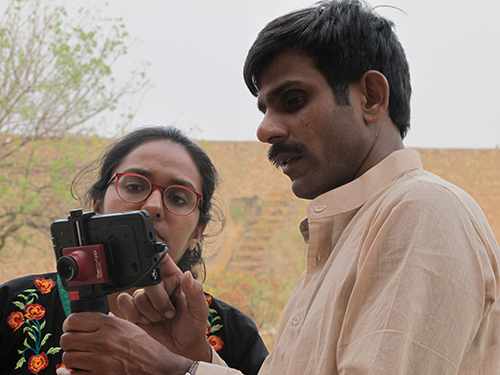 Sreekumar Menon followed a degree in Physics with a Masters in Conservation of Works of Art from the National Museum Institute, New Delhi, in 2001. He worked with Indian National Trust for Art and Cultural Heritage, New Delhi, and undertook internships in the conservation of easel painting at the Hamilton Kerr Institute, Cambridge, UK and at the Stichting Restauratie Atelier Limburg, Maastricht, The Netherlands. In 2012 he began a PhD at the Courtauld on ‘Early period Buddhist wall paintings of Ladakh from the 11th to early 13th centuries: Materials, techniques and conservation implications’ where he is an AkzoNobel scholar.
Sreekumar Menon followed a degree in Physics with a Masters in Conservation of Works of Art from the National Museum Institute, New Delhi, in 2001. He worked with Indian National Trust for Art and Cultural Heritage, New Delhi, and undertook internships in the conservation of easel painting at the Hamilton Kerr Institute, Cambridge, UK and at the Stichting Restauratie Atelier Limburg, Maastricht, The Netherlands. In 2012 he began a PhD at the Courtauld on ‘Early period Buddhist wall paintings of Ladakh from the 11th to early 13th centuries: Materials, techniques and conservation implications’ where he is an AkzoNobel scholar.
He is a partner of Art Conservation Solutions, managing a variety of painting conservation projects in India.
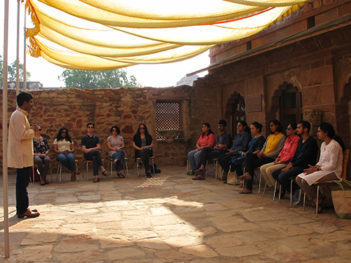
Menon began conservation projects with the Courtauld at Nagaur in 2007 and was a team member of the Courtauld conservation programme at Tango Monastery, Bhutan. He was instrumental in setting up the Leon Levy Conservation Centre in Nagaur, served as Programme Manager since 2015 and continues that role in 2019.
Publications:
M. Pinto, M.S.Gill, M. Georgakopoulou and S. Menon, ‘Examination of 14-15th Century Buddhist Wall Paintings from a Cave Complex in Saspol, Ladakh’ Journal of Archaeological Science : reports 21, Elsevier, 2018, 259-67
M. S. Gill, Carolina. P.R and S. Menon ‘Materials and techniques : Early Buddhist wall paintings and sculptures at Sumda Chun, Ladakh‘, Studies in conservation, Vol.59, Issue 5, Maney Publishing, London 2014, 300-13.
C. Martin de Fonjaudran, S. Menon and M. S. Gill, ‘Sumda Chun and other early wall paintings in Ladakh: practical and ethical conservation issues from failing structures to obscuring surface layers’, in D. Park, K. Wangmo, and S. Cather (eds), Art of Merit: Studies in Buddhist Art and its Conservation. Proceedings of the Buddhist Art Forum 2012, London, 2013, 203-18.
C. Martin de Fonjaudran, S. Tringham, S. Bogin, S. Menon and K. Jasol, ‘Cultural identity, conservation approaches, and dissemination: conserving the wall paintings of Nagaur Fort, Rajasthan, India,’ in ICOM-CC 16th Triennial Conference Proceedings, Lisbon, 2011 (e-publication, no pagination)
S. Menon and M.S. Gill, ‘Conservation of oil paintings of Raja Ravi Varma’, Conservation of Cultural Property in India, Vol. 39, Indian Association for the Study of Conservation of Cultural Property, New Delhi, 2011, 26-32.
M.S. Gill and S. Menon, Condition assessment and mapping of decorative features on monuments. In Agrawal O.P., Sinha N., and Singh S.(eds), Conservation Issues in Asia (Asian Regional Cooperation Conference, New Delhi 2008), New Delhi, INTACH, 2009, 9-17
Assistant Programme Manager: Aishanya Paliwal
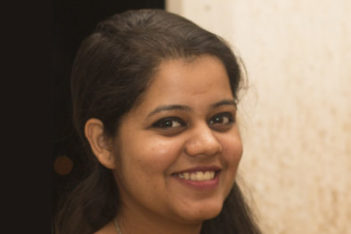 Paliwal did her bachelors in architecture from Manipal University, Jaipur. She worked with Indian National Trust for Art and Cultural Heritage, Bhopal Chapter. A participant of Leon Levy Foundation Centre for Conservation Studies programme in 2018, Paliwal is currently working as a freelance architect.
Paliwal did her bachelors in architecture from Manipal University, Jaipur. She worked with Indian National Trust for Art and Cultural Heritage, Bhopal Chapter. A participant of Leon Levy Foundation Centre for Conservation Studies programme in 2018, Paliwal is currently working as a freelance architect.
She will be joining the Leon Levy Conservation centre team in 2019, assisting with the management of the programme.


